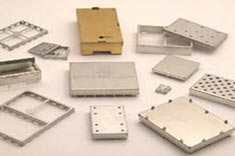EMI Shielding Products
- Custom Gasket Fabrication
- Connector Gaskets
- Bonded O Ring
- Custom Gaskets
- Conduct-O-Knit Knitted Wire Mesh
- Conduct-O-Seal Combo Gasket
- Conduct-O-Elastomer
- Conduct-O-Seal Oriented Wire in Silicone Gasket Material
- Conduct-O-Mesh Tape
- Conduct-O-Foam
- Conduct-O-Bond
- Optical Filters For Electronic Displays
- Shielded Vent Panels
- 300 Series
Selection of Seal Cross Section
Electro magnetic interference, or EMI, is a disturbance that occurs when an external force negatively affects an electrical component. This type of interference can degrade the productivity of an electrical circuit to the point where it completely stops functioning. Both natural and man-made sources are responsible for emitting EMI. Shielding gaskets are used to isolate one electrical component from another. EMI shielding gaskets are important tools that help electronic components function without being interfered on by radiation. There are some general rules to help with the selection of seal cross sections.

Flat gaskets: When utilizing a flat gasket, it is important not to locate holes closer to the edge than the thickness of the casket. Also, it is crucial to not cut a web narrower than the gasket thickness. Flat gaskets should also never be deflected more than 10 percent. The standard thickness for a flat gasket is 0.0020, 0.062, and 0.093. The flange should be bent outward so that all screw and bolts are protected from penetrating the shielded compartment. If the flange is bent inward to save space, the gasket holes should fit tightly around the threads of the bolts. This will limit the occurrence of leakages along the threats and into the compartment.
Shaped or Molded Gaskets
Shaped gaskets are effective because gasket deflection is easily controlled and larger deflections can be accommodated. For these gaskets, O-ring cross sections are recommended because they can shield more easily under a specific load. D-shapers are also excellent because they can be designed to host any groove cross section. Groove designs provide metal-to-metal flange contact and do not need as many fasteners, which minimize the amount of routes where leakage can occur.
Hollow Gaskets:
Hollow gasket designs are extremely useful when there are large gaps and low forces. These gasket designs are less expensive than most designs and can be procured without attached tabs. These gaskets, combined with tabs, are referred to as P-gaskets and have a minimum wall thickness of 0.020, depending on the design material of the gasket.
EMI Shielding
If you are interested in learning more about EMI shielding gaskets, seal cross sections, or EMI in general; contact a local professional for more information. It is important to properly shield electronics from EMI, in order to insure that they work in times of need. A shielding gasket expert can direct you towards the right type of gasket, for a specific application.
Related Reading
- Mounting a Shielding Gasket
- Understanding Oriented Wire Shielding and how it Works
- EMI use of Gaskets in Military
- The Science of Shielding
- Shielding Gaskets and Corrosion
- Integrated Circuits Have Problems with EMI
- RFI and EMI: Frequent Questions
- Difference between EMI and EMC
- RFI Shielding in the Medical Field
- Common Shielding Metals



